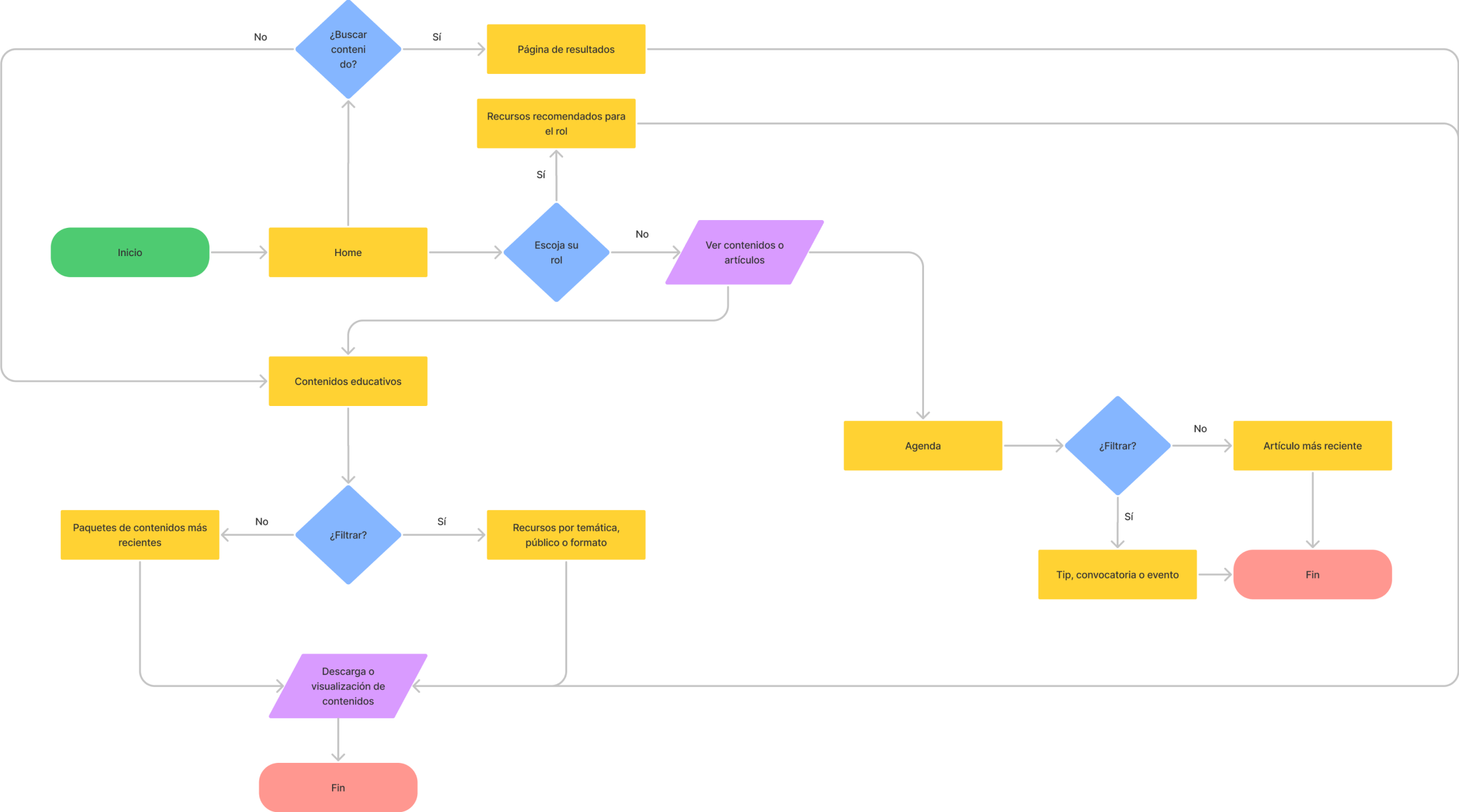Challenge
How to transform a website with more than 17 years of trajectory and millions of users to improve discovery, retention, and conversion?
Background
Colombia Aprende was a website too big and too complex. It was a platform that looked dated and performed poorly.
With 81,000 educational resources, more than 70 microsites, five sections, and five sub-sites for every audience of the educational community of Colombia (teachers, students, family, directives, and researchers), the whole experience was messy and lacked intention.
Before I joined, Colombia Aprende’s team didn't have a connection with their users. The portal was full of meaningful resources, but the process of finding and using them was convoluted.
Process
At first, the stakeholders weren’t keen on redesigning Colombia Aprende, so we began with a heuristic evaluation of the old platform. Our goal was to audit all our usability problems.
After gathering feedback from 20 teachers and directives from around the country, we validated our findings with an external group of experts in the Universidad EAFIT.
Insights
Many spaces that were predominant in Colombia Aprende, were also unused and outdated. Our content offering was literally buried through layers of unnecessary clics.
Mostly all of our users bounced after finding and downloading the specific resource they needed to prepare their classes. They came back months or years later.
Only one of our offerings of content was used: Contenidos para Aprender. This is a collection of resources for teaching and promotion of basic skills.
In this stage, It was crystal clear that we have to transform the whole user experience. It wasn’t just about ease of use, we needed to make Colombia Aprende useful, enjoyable, and most of all, equitable.
To redesign Colombia Aprende and improve the whole user experience, we mixed the Double Diamond framework with Lean UX.
Understanding the challenge
The main barrier to transform Colombia Aprende was the internal user. Colombia Aprende’s team and the stakeholders of the Education Ministry opposed changing a platform with more than 17 years of existence.
While we conducted research interviews with our main audience (teachers of the public sector), we also had to make workshops, empathy maps, and value proposition canvas with the participation of almost every area of the Ministry.
Our research, in that sense, included:
- Understanding the user goals and needs.
- Uncovering pain points of both end users and internal users.
- Determining the goals of everyone involved with Colombia Aprende, from the administrators throughout the teachers and directives.
- Auditing the content and benchmarking similar platforms around the world.
Setting the road
After filtering all the data, we defined one main area of focus:
Create content collections, a new service in Colombia Aprende that was pivotal to the user journey. We defined a way to pack and present multiple educational resources by topic, audience, format.
Our goal was not only to organize our content offering. We wanted to provide users with context and guidelines to improve appropriation and discovery.
In a content collection, users don’t see individual resources. It’s more like a kit that the team of Colombia Aprende publishes to achieve a specific goal. It could be the promotion of certain skills, the positioning of an active learning methodology, or whatever the areas of the Education Ministry wanted to achieve with the educational community.

Also, by brainstorming and card-sorting, we created a new sitemap with the team, where the content section was the most important and visible through the whole navigation structure.
And lastly, we decided to approach this transformation with a socio-technical perspective to provide a clear roadmap for sustainability and scalability, two things that worried our stakeholders.
This whole package allowed us to refine the user stories, define the epics, and create the timeline of what we needed in terms of development, design, and communication.
Prototyping and testing
After we defined the new visual identity of Colombia Aprende, we created the first mockups on Figma and published them on InVision to gather feedback and validate the user flow.
That’s how we spot flaws, for example, in our original version of the content collections, such as the inability to arrange and filter resources.
We built new categories with the support of Colombia Aprende’s content management staff, based on teacher feedback. We’ve also done some A/B testing to include these new options in the final user interface.

Results and lessons learned
We have seen a significant increase in conversion since the launch of the new Colombia Aprende in October 2020. Content collections aided us in positioning other resources in addition to Contenidos para Aprender.
We’ve also been able to keep iterating and polishing the user experience without further resistance from our stakeholders thanks to agile software development and user-centered design processes.
Some of the lessons learned in this project were:
- Users come from everywhere: It wasn’t just about our end users. To achieve lasting transformation, we had to include Colombia Aprende’s staff and key stakeholders from different areas of the Ministry.
- It all begins with a vision: It’s fundamental to gather insights and analyzing data for both improving user journeys and creating a common vision, an inspiring goal.
- Keep it simple: It may sound cliche, but when you’re dealing with a website as large and old as Colombia Aprende, you have to give yourself permission to make it a little bit smaller, to narrow the focus.
